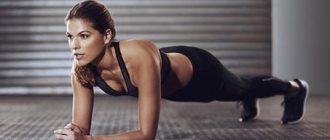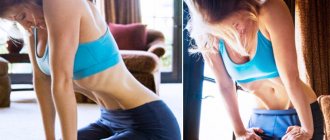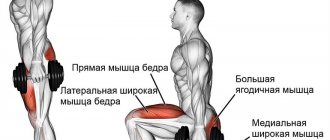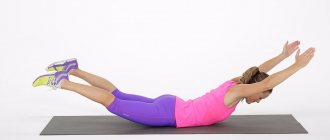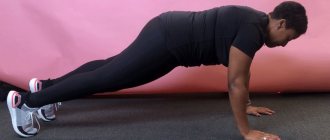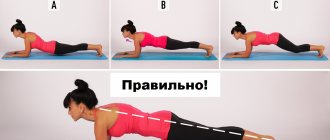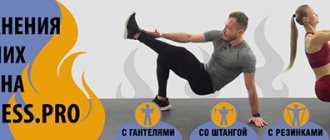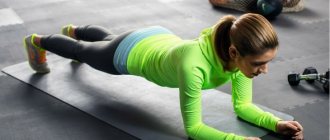A very popular exercise now is the side plank. It helps to work the muscles of the abs, shoulders, arms and legs. Many people choose the plank because training can be done at home. They do not require any additional equipment. You don’t have to waste time visiting gyms, which is especially important in the modern pace of life.
The side plank differs from the classic plank in its technique and greater load on the muscles. With this exercise you can diversify your training program.
The benefits and harms of exercise
The plank in the side position has virtually no disadvantages, there are only contraindications.
The main advantages of the side plank:
- Involvement of a large number of muscles without dynamic impact.
- Working out not only the external, but also the deep layers of muscles.
- Load on the rectus and oblique abdominal muscles simultaneously (with an emphasis on the latter).
- Prevention, reduction of pain and discomfort in scoliosis, kyphosis and other diseases of the spine.
- Development of flexibility and coordination.
- Improved posture.
Benefits of the plank
Exercises contribute to the development of body characteristics, namely:
- strengthens and develops muscles;
- develops concentration;
- makes a perfect waist.
Find out more about all the benefits. The main effect of the exercise is to create tight corset muscles, especially the abdominal and back muscles. The neck muscles will also be used, which will significantly improve your posture.
This method allows you to increase the endurance of your shoulder muscles by strengthening them during training.
Biceps development is also stimulated, making it easier to work the biceps brachii muscles when the upper part is held at arm's length. During training, the chest, lower back, buttocks, abs and calves are strengthened.
From a psychological point of view, the benefit is improved concentration, the importance of which cannot be underestimated. The exercise is goal focused. This is a great opportunity to work on yourself and moderate your temperament so as not to give up.
This exercise will appeal to those who have decided to start the fight against belly fat and a fuzzy waist. The plank not only perfectly eliminates these difficulties, but also makes the body look perfect with a thin waist and attractive ankles. But we should not forget about a balanced diet and give up cardio training.
For weight loss
The effectiveness of the plank, like any other exercise, is measured by the number of calories you spend on it. Of course, this should not be considered a panacea that will “lose weight” in the blink of an eye.
Absolute fact : dynamic versions of this exercise consume more calories than static ones. And strength exercises will be used.
Of course, constantly doing planks will make itself felt, but only in combination with a diet. The effect of losing weight will appear if you spend much more energy than you get from food, and your body is not particularly interested in how you do it.
The plank helps to make your figure slim and tones the abdominal and side muscles.
But you shouldn't get too carried away. Research by sports scientists has shown that excessive enthusiasm can lead to disturbances in neuromuscular connections.
In addition, after a certain level of muscle training, static exercises cease to have a training effect - progress stops.
No amount of exercise on its own will make you lose weight. When it comes to calorie intake, of course, it is better to do joint exercises - squats, deadlifts, bench presses.
We especially note that we do not recommend the weight loss plank for beginners. Even if you are not overweight (10 kg or more), it is best to start your “sports career” with traditional exercises.
A beginner has poor coordination, no established vector of movement and tone of muscle strength. Beginners are not yet accustomed to maintaining a neutral back position and releasing neck tension during exercise.
All beginners, when standing on the plank, make health mistakes: overloading the neck muscles (hello, headache), bending the back (warming ointment), and so on.
If you are overweight, have mercy on yourself and your joints and spine. Start with physical therapy and walking/swimming.
For the press
These photo results came after a 60-day course of high-intensity interval training 4-6 times a week and after a serious diet.
Static tension exercises are not suitable for developing abdominal muscles, but are excellent for strengthening, tone and endurance of all abdominal muscles at the same time
The plank is a basic exercise that strengthens the abdominal muscles. If you delve into the technical details, the plank belongs to the class of isometric exercises, that is, it is static and does not cause movement of the joints.
For the back
Planks significantly reduce the severity and frequency of back pain. This is because the spine becomes more flexible and stronger. The plank also trains the back muscles, especially the upper part. According to the American Physical Education Committee:
“Because the plank is a static exercise, the minimal movement with high tension in the deep abdominal muscles provides the opportunity to strengthen the skeletal system, which helps reduce lower back pain.”
For the mood
In fact, many workouts improve your mood and the plank is no exception. This is a unique exercise because it can stretch and tighten the muscles during exercise, and then gives a feeling of relaxation throughout the body.
The plank is especially needed for people who lead a sedentary lifestyle. Exercise relieves stress after a busy day at work and brings a positive mood.
For posture
To do a plank correctly, you need to flex your abdominal muscles. This is important for maintaining an upright position. In particular, to regulate the coordination of movements to enhance balance.
Want to know how stable you are? Try doing a side plank with your legs elevated - get into position and then slowly lift your leg. How much can you stand?
Lower your leg, return to the starting position, repeat the exercise with the other leg. The plank is a universal exercise. The process uses all the muscles necessary to form correct posture. These are the muscles of the back, chest, arms, abdomen and neck. If you often perform this common exercise, you will not notice how you will sit or stand with a more even back.
How to do a side plank correctly: technique
As with any static movement, it is important to understand how to do the exercise correctly. Otherwise, the side plank will lose its effectiveness, since any mistakes will place the load on other muscles. Therefore, the whole technique comes down to mastering the correct position of the body and maintaining the position for as long as possible.
Side plank technique:
- Lie on the floor, with emphasis on your arm bent at the elbow (angle 90 degrees). The forearm and hand act as support. Bring your legs together and place one foot on the floor.
- Lift your hip and pelvis off the floor and lift them up so that your body forms a straight line.
- Hold the position for as long as possible, then lower your hips to the floor and repeat on the other side.
It is extremely important that in the side plank exercise, the same amount of time is spent on each side. Failure to comply with this rule can lead to the development of muscle imbalance.
also do a side plank with emphasis on the palm , the technique is the same as with emphasis on the forearm.
Plank 1535
The Planck group was founded in Moscow in 2001. This is one of the few musical groups in our country that perform their material in synth-pop or ambient style. That is why the circle of connoisseurs of Planka’s work is not as wide as that of most domestic pop groups, however, all of the group’s compositions are distinguished by their originality and uniqueness. The group consists of only two people, who were its founders. This is Gulnara Miftakhova - soloist and Mikhail Ignatov - songwriter. The group also includes equipment, including the Gerda audiovisual model and GU1 1iver F0il programming.
The history of the birth of the Planck group is very peculiar and extraordinary. It all started when two future members of the group decided to make a feature film, and not spend any money at all. And they succeeded. Gulnara starred in the main role, and the cameraman who carried an amateur camera behind the filming participants was Mikhail Ignatov. But the most important trump card of this picture was the soundtrack, which was recorded especially for it. The song called “Deadly Sin” later became the debut single of the Plank group, thanks to which it became famous.
At the very beginning of their popularity, the group recorded their debut album, which was called “The Pistol Finger,” and after its release briefly disappeared from the stage. However, in 2007, Planka returned again, and the group’s new single was the song “Forgot/I don’t remember,” and a year later the second album “I:NOT:IN:THE” was released. The album brought great success to the group, and it was decided to create a special release that would collect the best compositions of the group.
It is also worth noting that in parallel with the activities in the Planck project, its participants are creating another project, which is called “1989 Constant”. It includes the release of audiobooks and songs written in ambient style. The project was also involved in the release of all previously rejected tracks of the Plank group, remixes of existing hits and videos.
The Plank group is one of the most extraordinary projects on the Russian stage. Of course, the main feature of the band is their style, which ranges from rhythmic and harmonious synth-pop to drawn-out and thoughtful ambient. Therefore, this music is not intended for a wide range of listeners, but only for those who really understand musical trends and can appreciate work that is not written off in the generally accepted pop format.
Nowadays, anyone who wishes can attend Planka’s performance. They give both solo concerts, which most often take place on small stages, and you also perform at various concerts and festivals. Most often you can see Planka on the stage of a concert dedicated to the hits of the nineties, or at an autoradio disco. The group also has nine studio albums, which contain both original versions of compositions and remixes of them.
Complicating the exercise
The side plank has the greatest number of variations. Some types increase the load, while other variations switch it to other muscle groups.
With the failure of the hull
The version of the side bar with a dip in the body is an attempt to add dynamics to the bar. This technique puts more stress on the oblique abdominal muscles, but it should be done carefully, as dynamic loads can affect the width of the waist.
Technique:
- Get into a regular plank position.
- Lower your pelvis down without touching the floor.
- Try to bend as low as possible, doing bends for 4-6 seconds.
Due to the increased risk of injury, it is correct to do a side plank without rounding your back.
With your leg up
The leg-raised version of the side plank is a classic technique for increasing resistance without changing technique. Performed by raising one leg up. To prevent the load from switching to other muscles, it is optimal to keep the leg in a horizontal position.
Raising the knee to the elbow
This is a dynamic exercise option that requires an average level of physical fitness (not suitable for beginners). To do the side plank exercise correctly in this style, you need to completely master the classic version.
Technique:
- Get into a classic plank position. Place your free hand behind your head.
- Begin to bend your leg (upper) at the knee and lift it over the top to your hand.
- The closer the knee is brought to the elbow and the higher it is directed, the more effective the exercise will be.
With body rotation
The most powerful version of dynamic planks for oblique muscles.
Technique:
- Get into a classic side plank position. Raise your free hand up.
- Slowly lower your arm down and turn your shoulder and body inward.
- At the lowest point, the free arm should be slightly bent at the elbows and directed between the floor and the body.
Advice from professionals
At first, performing this type of exercise is quite difficult. But if you follow some tips, you can achieve results from the exercise much faster. The following professional tips will make your job easier and get the most out of your workout:
- You should train every 3-4 days, increasing the time by 5-10 seconds each time.
- Before the main work, you need to do a warm-up.
- Before you begin complex variations, you should practice the classic version of the exercise.
- You should not be afraid to do the exercise; it is almost impossible to get injured while working with this exercise.
- Before fixing the pose, you should tense the muscles of your buttocks and abs.
- You need to look forward all the time, without tilting or bending your head, and you should also strain your neck.
- To quickly master the technique of performing the exercise, you should practice in front of a mirror. This will make it easier to spot errors and correct them.
Working with this exercise is difficult only at first. After a couple of lessons it will be much easier to do. The main thing is not to rush, and not to load the body too sharply. Since a sharp increase in load will lead to overload of the body and injury.
A beautiful figure is the dream of many women. Some girls think that it is impossible to achieve the desired result without constant training. But this is not true; if you normalize your diet and choose the right exercises, you can lose weight in one month. The side plank will help you achieve the desired result. To find out the positive aspects of the exercise, you only need to look at which muscles work when doing the side plank. This exercise is not that difficult, and almost does not harm the body if performed incorrectly. If you correctly practice the technique of performing the exercise, you can quickly lose weight, pump up the muscles of the whole body and strengthen the body.
Implementation recommendations
- As with any type of plank, it is best to perform the movement on a separate day . This will allow you to do 4-6 sets productively.
- When introducing strength training into your routine, it is important to consider which muscles are involved in the side plank you are using. For example, if we are talking about a plank with a body turn, it is optimal to place it in a block for working out the abs, along with other movements for the oblique abdominal muscles. The variant with a core failure, where there is a strong stretch, is best done at the end of a back workout, when the muscles are already tired. Additional stretching will speed up recovery.
- The main criterion for tracking progress is the time that an athlete is able to hold within one approach. Per workout you should perform 3 to 6 sets on each side.
- In versions with dynamic loading, it is recommended to take into account not only the number of repetitions in the approach, but also the total execution time.
What muscles work?
The side plank is very popular, but not all women know which muscles work. Because of this, when drawing up a training program, some people make mistakes because they overload certain parts of the body. To avoid mistakes and achieve quick weight loss, it is recommended to know exactly which muscles work when performing a complicated plank:
- Delta.
- Triceps.
- Biceps.
- Pectoral muscles.
- Trapezoid.
- Serratus, rhomboid, quadratus lumbar muscles.
- Upper, side muscles, and lower abs.
- Gluteal muscles.
- Calf muscle.
- Iliotibial tract.
As you can see, the side plank allows you to pump up almost the entire torso and quickly lose weight. And if you do it correctly, the result will not be long in coming.
